What Is Mainlining Cannabis And What Benefits Does It Provide To Your Plants?

Even if you’re an experienced cannabis grower, you may not yet know about mainlining. This is a fairly new technique for increasing yields and managing canopy space. Since mainlining’s inception, the technique has spread like wildfire, securing a space in countless professional grows and even more home gardens. Intrigued? Let’s learn about mainlining and how it can help your cannabis garden.
Mainlining Cannabis Explained
The definition of mainlining can change depending on context, so we’ll break it down here. In simplest terms, mainlining is a type of plant training technique that unites elements of topping and low-stress training (LST). The goal of mainlining is to channel a plant’s energy into a few evenly developed main branches instead of one dominant cola. To achieve this, growers train the plant to form eight symmetrical branches sprouting from a central “main line.” It’s also sometimes referred to as manifolding, since the method involves creating one main hub from which smaller branches shoot off.
Benefits Of Mainlining Weed Plants
There are three primary benefits to mainlining. The first is most obvious: mainlining can boost the yields of your cannabis plants. It’s also a fairly easy technique to perform. After you create your plant’s main hub, it doesn’t require much maintenance. Finally, and perhaps most importantly, mainlining reduces the amount of height your plants need.
Bigger Plants, Bigger Buds, Bigger Yields
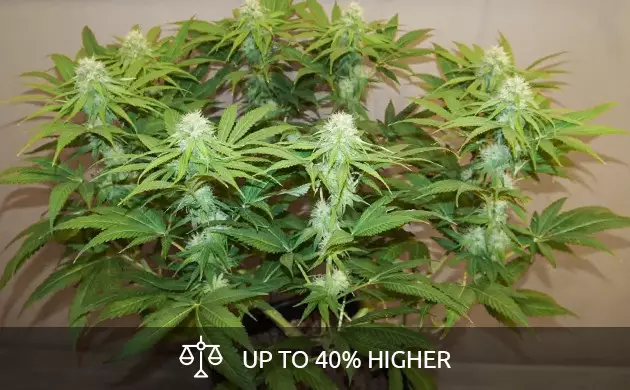
Mainlining can increase yields by up to 40% compared to traditional growing methods. The earlier in the veg stage you begin, the more likely you are to maximize those returns. While your plants won’t be growing any higher than non-mainlined plants, that doesn’t matter as much. Instead, your plant will focus its energy on creating huge, dense buds that are packed closely together. These buds are akin to the nugs you’d normally find high up on the cola of a non-mainlined plant, except they’re everywhere.
Little Effort Required
In contrast to many other types of plant training, marijuana mainlining can take significantly less time and effort. There are a few reasons for this. First, mainlining is a perfect “set it and forget it” strategy. It’s like following a recipe. As long as you stick to the playbook when mainlining, it’ll always work. By combining mainlining with a feeding system, your garden can essentially grow itself. Second, mainlining significantly reduces your canopy maintenance. All you need to do is top the plants a few times and prune away some extra plant matter.
Perfect for Indoors And Outdoors

Regardless of whether you’re an indoor or outdoor grower, mainlining provides several benefits. For example, mainlining can help indoor growers find the vertical space they need to successfully cultivate Sativa plants. Because Sativas grow so tall, indoor growers often find these plants reaching into their lights. Mainlining indoor Sativas makes them significantly more manageable by reducing their final height without negatively impacting yield.
Outdoor growers can take advantage of a higher degree of control over the shape of their plants. Mainlining also helps outdoor growers keep a low profile. Since plants need less height, it’s easier to grow outdoors stealthily using mainlining. Finally, the compact dimensions of mainlined plants make them resistant to mold and mildew infections.
Why Does Mainlining Work?
When you mainline a plant, you’re focusing all of its energy in a few places that are all the same distance away from your plant’s root system. Since every branch grows from the same spot, the plant nourishes each of them equally. It’s the same idea that plumbers use when they create multiple branches of piping from a single hub. That’s also why many growers refer to this method as the “manifolding technique.” By spreading energy equally throughout a plant, a grower can minimize the number of airy, larfy buds and focus on creating heavy, thick flowers.
Mainlining Cannabis Step By Step
Here, we’ll give a detailed analysis of how to integrate marijuana mainlining into your own home garden. We’ll begin by discussing the equipment you’ll need to pull off mainlining successfully. Then, we’ll launch into a step-by-step guide that will help you perfect your technique the first time you apply it.
Equipment Needed For Mainlining Cannabis
There isn’t much that you’ll need in terms of gear to pull off mainlining successfully. You’ll just need some green plant wire for initial setup and some softer plant ties to support your buds once they start getting heavy. Don’t forget a grow lamp strong enough to reach through the entire canopy — typically, a 150-watt HPS, MH, or an equivalent LED will be sufficient for this task.
Step 1 – Plant Your Roots
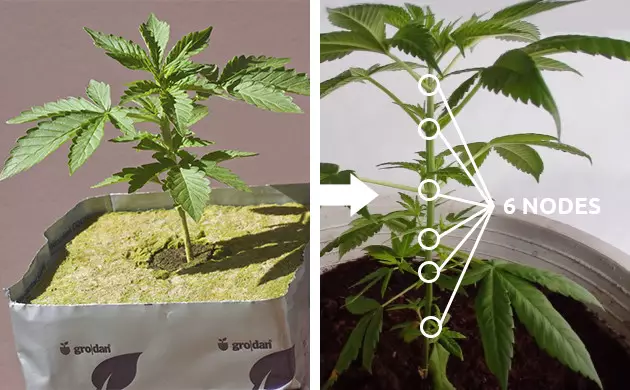
Germinate a seed, plant it using your preferred method like a starter cube or rock wool cube, and wait for it to take root. Then, transplant it into a larger container and wait until the plant develops six nodes – three on each side. This will allow your mainline cannabis plant proper airflow below its hub and prevent a myriad of infections from developing.
If you’re planning on taking any clones from your plant, now’s the time. After you establish your main line hub, you won’t be able to take any more clones. You’ll want to take your cuts after the third node on each side of your main branch.
Step 2 – Topping

Once your plant has three healthy nodes, top it. Only do this after you have plenty of dieback, or extra plant matter beyond the node. Your plants will need enough dieback to seal their vascular system without affecting any of the nodes below the top. If you top too low, it may lead to nutrient transport issues down the line, undermining the benefits of the mainlining technique entirely.
Finally, if you don’t give your plant enough room when topping, your main line can split in half after your buds start getting heavy. This will shock the plant, stunt its growth, and also open the way into its vascular system for infections.
Step 3 – Making The Main Line
Next, it’s time to create your main line. Give your tops a few days to develop – they need to have four nodes each. Then, cut off all the growth from both sides of the second node on each top. This gives plants more room to grow and makes them easier to train.
Now, remove all growth below the third node. This node will now become the center of your marijuana mainlining hub. Leave nothing but the growth pair (symmetrical branches) coming from the third node. This will force your plant to distribute nutrients to both sides evenly. You may want to leave one fan leaf growing on either side of your plant, which will help your plant recover from all the stressful training it’s receiving.
Step 4 – Secure Main Lines

Use soft plant ties to secure both of your tops in a perpendicular position to your stem. The end result of a cannabis manifold should be a plant that looks like an uppercase “T.” Be extremely gentle when you do this, as you don’t want to damage your plants.
If you do happen to damage your plants during training, it’s not the end of the world. You can use tape to seal any holes in your plant and correct the damage. If necessary, make sure the broken branch has the additional support it needs. You can use a stake or more green ties to fix this.
Step 5 – Top Main Branches
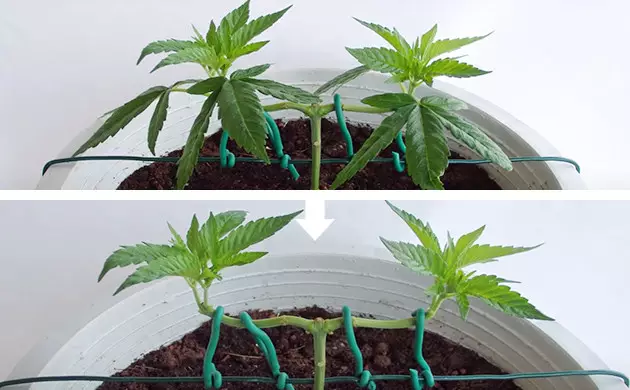
Give your plants some time to recover from the manipulation you just performed. This is the one point in the marijuana mainlining process that requires the grower to use their own intuition. Once you’ve determined that your plants are doing well enough to proceed, top all of your main branches.
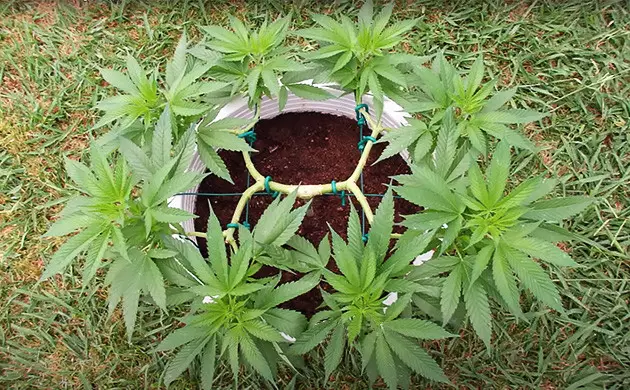
This will double the total number of branches on your plant. Allow your garden some more time to recover, then top again. Repeat this process until you have eight main branches. Then, remove all of the extra growth that’s not coming from one of these main colas.
Step 6 – Tomato Ring (Optional)
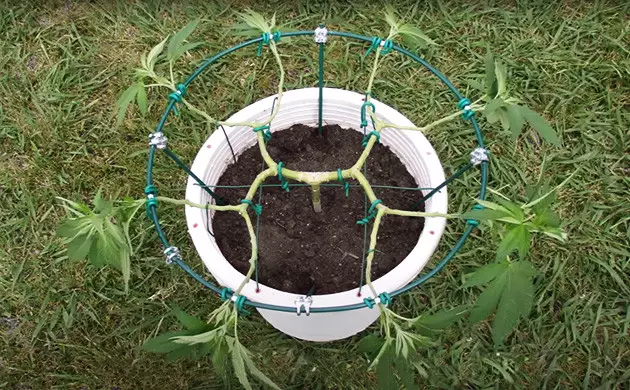
For extra control over the complete shape of your cannabis manifold, use a tomato ring. These are metal hoops built into a frame that you can tie your branches to. Tomato rings are particularly helpful later in the flowering phase, when your nugs get big, fat, and juicy. Mainlined buds tend to collapse under their own weight, and a tomato ring can help prevent this.
Step 7 – Flip To Flower
At this point, you need to focus on nurturing your plant through the veg phase. You’ll probably notice that the mainlining veg time is significantly longer than a regular veg cycle would be. That’s because it takes time for a plant to recover from the aggressive pruning and training that mainlining requires. The exact amount of time will depend on the strain you’re growing. Continue to train your plant horizontally throughout the veg phase. Once they’re ready, you can flip your lights to produce 12 hours of light and 12 hours of darkness per day. You can only mainline photoperiodic strains, not autoflowers (more on this later).
Mainlining Cannabis: Helpful Tips And Tricks
Outside of the basic process surrounding the cannabis mainlining/manifolding technique, there are some best practices every grower should establish. We’ve included some helpful insights below to help you nip any potential problems in the proverbial bud.
Choose A Strain For Mainlining Wisely
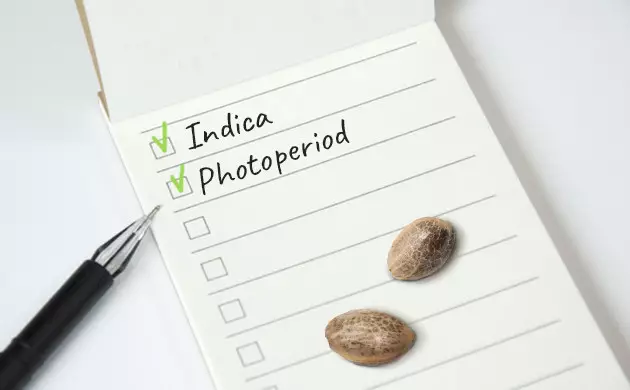
To properly maximize the benefits of marijuana mainlining, you’ll need to carefully consider what strains you’re growing. In general, mainlining works best with strains that exhibit single-cola dominance. This trait, common among Indicas, means that one of the plant’s colas grow higher than the rest. The end result is a shape similar to a Christmas tree.
Additionally, use only photoperiodic strains when mainlining. Autoflower strains switch from veg into flower automatically. Because of this, they’ll never be able to experience the extended veg cycle that mainlining requires to be successful.
Start From Seed
Mainlining clones isn’t the best idea. They don’t develop the same kind of single cola dominance that mainlining requires, regardless of their strain. Clones tend to develop asymmetrical colas, slightly offset from one another in height. As a result, mainlined clones don’t have the same structure as mainlined plants from seeds, and they’ll distribute their nutrients differently. While you can still apply this technique to clones, it’s best to start mainlining from seeds.
Combine With LST
Mainlining is essentially a combination of LST and topping. However, you can use LST to take your marijuana mainlining even further. Just remember that everything you tie down will eventually turn upward to face the source of light in your garden.
Watch For Injuries
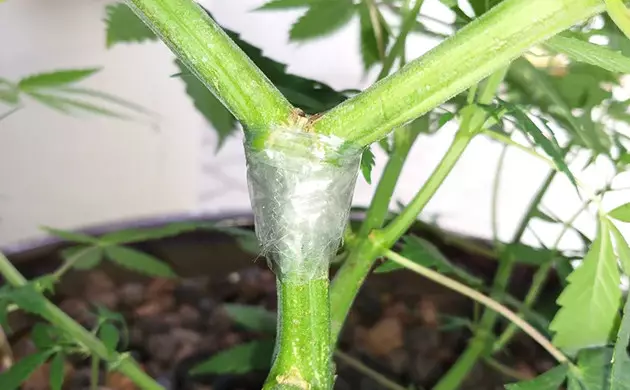
The biggest issue to keep an eye out for when mainlining cannabis is plant damage. Mainlining can be a highly stressful technique on branches, and splits in stems are common at node points. As we mentioned earlier, if you act quickly, you can fix split stems and other plant injuries by wrapping the break with tape. Duct tape, electrical tape, and even scotch tape can be used on cannabis plants to varying degrees of success. Just ensure that the tape isn’t constricting your stem once the plant is healed, as this can offset nutrient flow and defeat the entire purpose of the technique.
End Of The Line
Now that you have a better understanding of the benefits of marijuana mainlining and how the process works, you’re ready to deploy it in your own garden. The most crucial aspect of mainlining is patience. Don’t rush your plants – make sure to give them the time they need. It may take extra time, but the increase in weight and quality is definitely worth it.
Herbies Head Shop expressly refuses to support the use, production, or supply of illegal substances. For more details read our Legal Disclaimer.








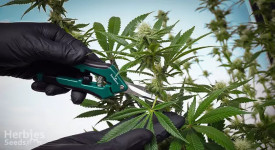
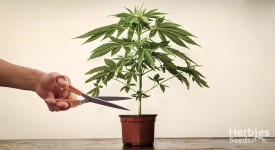
Thank you for leaving a comment for us!
Your feedback will be posted shortly after our moderator checks it.
Please note that we don’t publish reviews that: